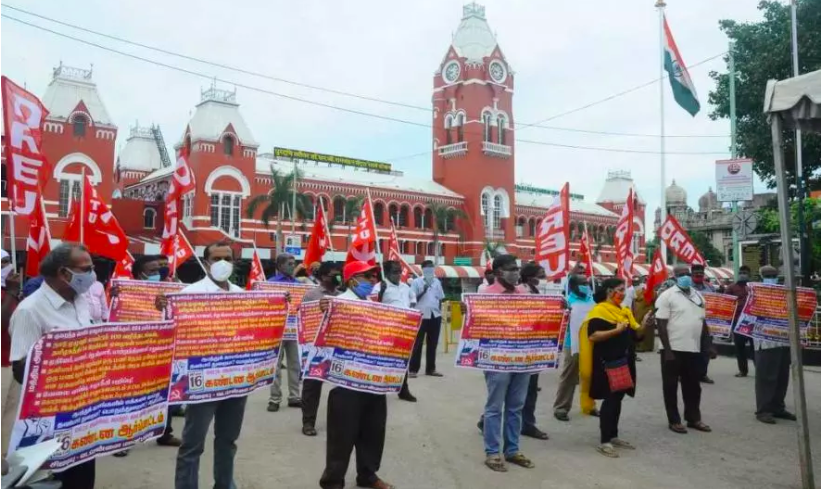2020: Of Derailed Disinvestments and Rejuvenated Employees’ Movements

Ever since 2014 – if union leaders or experts are to be believed – the Central Government has led a systematic onslaught on state-owned enterprises in the country. The Narendra Modi-led NDA government brought with it a privatisation spree; one that only got more aggressive since 2019, the beginning of the Bharatiya Janata Party’s second term, this time with a clear majority.
It was then of little surprise when this year, during the first Union Budget of Modi’s second innings as Prime Minister, the Centre pegged an ambitious disinvetsment target: to raise Rs. 1.20 lakh crore – nearly double of what was raised in the previous financial year – by putting public companies up for sale to corporate houses, domestic or foreign, all disguised in the name of “economic reforms.”
That such a disinvestment drive would strip the country of its national assets, as has been cautioned by trade unions; or that a change in ownership would lead to workers losing their jobs; or how strategic sectors will be exposed to the vagaries of the market, posed little worry before decision makers.
Cut to December however, and the current situation only invokes mixed feelings about how far the Centre’s could go on its chosen economic route, if at all. While the COVID-19 pandemic made sure that the government’s stake-sale ambitions were derailed, the crisis also provided the Centre scope to push disinvestment further. On the other hand, the virus-triggered restrictions on assembly hampered employees’ resistance plans but also reinforced the significance of the public sector in the economy, thereby giving a new fillip to workers’ movements.
With only three months left in this financial year, what has scuttled big-ticket disinvestment planned by the Centre is the depressed share value of public sector undertakings – a result of the pandemic-induced economic disruption. It comes as a challenge when decision makers are hell-bent on going ahead with the sale of ownership in Air India and in the Bharat Petroleum Corporation Limited (BPCL).
Incidentally, employees unions associated with both the state-owned enterprises are up in arms against privatisation. While it has been argued that a ‘revival’ is possible in the case of Air India, the latter is still generating a profit and holds strategic importance in regulating the oil sector, the unions argue.
While the pandemic did slow down the disinvestment process in both cases, it also gave respite to the unions. For example, the workmen unions at BPCL staged a two-day strike in the month of September to protest privatisation while also resorting to a legal course of action.
Similar industrial action was witnessed in the defence PSU Bharat Earth Movers Limited (BEML), Shipping Corporation (SCI), and railways’ navratna company Container Corporation (CONCOR) – all of which were slated for the disinvestment. However, the pandemic slowed down their disinvestment processes.
Such protests were also triggered by how the Centre sought to “take advantage” of the prevailing crisis. In June, a clarion call was made by Prime Minister Modi to ‘turn the COVID-19 crisis into opportunity’. It summarised the state of affairs and what the ‘Atmanirbhar Bharat’ package – released by Finance Minister Nirmala Sithraman a month prior – was all about. A Public Sector Enterprises Policy was announced which included a maximum of four state-owned companies in strategic sectors, with public firms in other segments to eventually witness privatisation.
Contrary to expectations, several nationwide programs were called for by the ten Central Trade Unions which protested and saw widespread participation by government employees. Workers also demonstrated against reforms in the coal sector. The reforms were also proposed under the package and a three-day strike was observed in July this year in at least 400 coal mines in the country and 75 establishments spread across nine states.
The package also included the corporatisation of the over 200-year-old Ordnance Factory Board (OFB), which triggered defence employees to call for an indefinite strike in all 41 ordnance factories, thereby forcing the Centre to defer its plan and return to talks with defence federations.
Despite the pandemic halting regular passenger services, the Centre opened 109 routes with 151 trains for private train operations at an estimated cost of Rs. 30,000 crores and floated a tender for the same. Efforts were made by the largest railway union – All India Railwaymen’s Federation (AIRF) – which pinned their hopes on the general public to join protests against the eventual privatisation of the public transport service provider.
Moving ahead, the movements by these government employees can only be strengthened while they hope for the general public to join in. The Centre, even as it finds itself with the opportunity to push the privatisation spree, will not be left completely unchallenged.
Get the latest reports & analysis with people's perspective on Protests, movements & deep analytical videos, discussions of the current affairs in your Telegram app. Subscribe to NewsClick's Telegram channel & get Real-Time updates on stories, as they get published on our website.
























